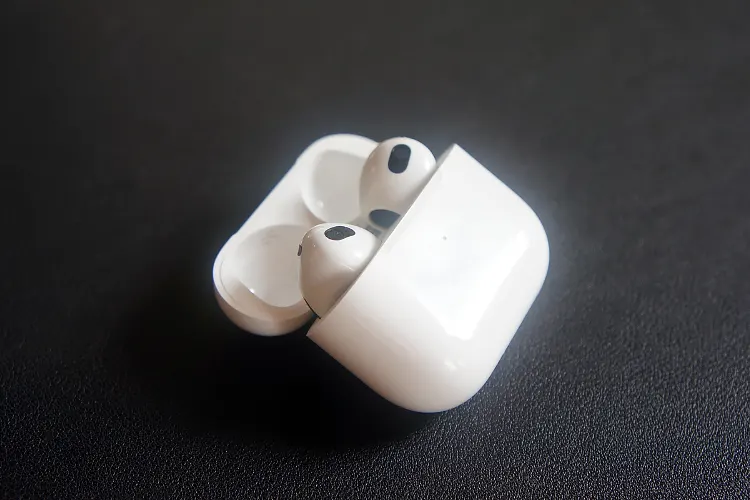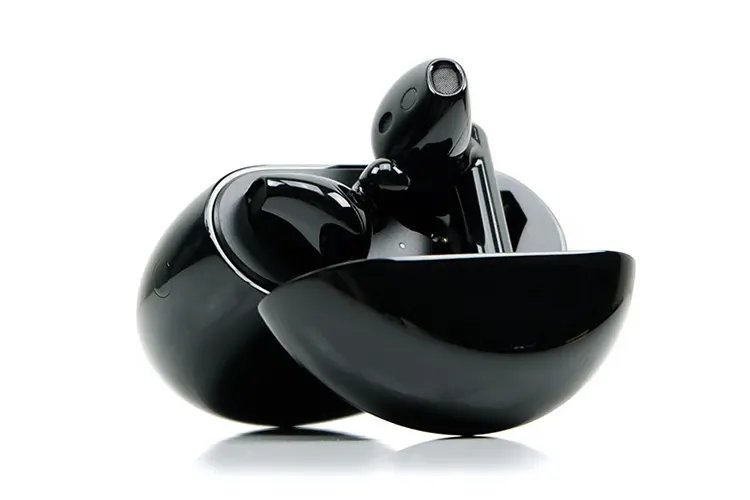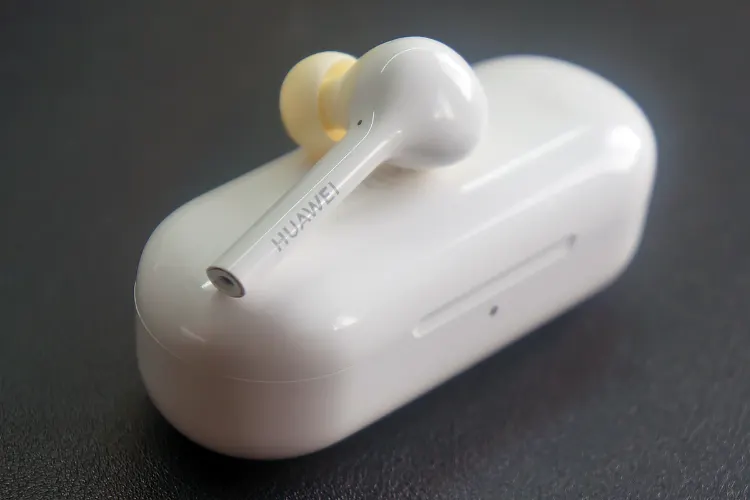Select Comparisons
Apple AirPods 3
Technical
The Apple AirPods 3 are equipped with an Apple-designed dynamic driver and a custom “high dynamic range amplifier”, however, I was unable to find any information on the size of the exact driver and any specifications on the amplifier used.
In comparison, the MOONDROP Golden Ages uses a 13mm full-range planar magnetic driver, similar to the ones used in pricier wired IEMs.
For its connectivity, the AirPods 3 has the proprietary H1 chip which enables a stable wireless connection via Bluetooth 5.0. This chip supports the AAC codec, ensuring high-quality audio transmission with compatible devices.
On the other hand, the MOONDROP Golden Ages supports Bluetooth 5.3, offering a more advanced connection and a wider range of codecs including SBC, AAC, LDAC™, and LC3 for superior audio quality.
Both of these TWS sets support ANC; in fact, the Freebuds 3 was the first set of earbud-style TWS to support active noise canceling.
In terms of battery life, the AirPods 3 offer up to 6 hours of listening time on a single charge, and with the MagSafe Charging Case, you can get up to 30 hours of listening time.
Comparatively, our testing showed that MOONDROP Golden Ages provide about 4.5 hours of listening time with the earbuds and an additional 14 hours from the charging case, which is less than the AirPods 3 but is still a respectable amount.
Design
The AirPods 3 uses a sleeker and more minimalistic design philosophy, in line with most of Apple’s products. Its cradle is constructed out of white glossy plastic with curved edges all around it. The cradle’s plain design does not attract any attention, similar to the earbuds themselves.
The Golden Ages has a larger cradle built out of lighter and cheaper-feeling matte plastic. Both the cradle and IEMs themselves are adorned with retro-inspired prints, invoking a sense of nostalgia for the days of the Walkman and cassette tapes.
The AirPods 3’s earbuds make use of an earbud-type form factor with no in-ear tip, making them sit in your ear instead, while the Golden Ages has a more typical IEM style of earbud.
Performance
With its duller, flat sound signature, the AirPods 3 does not hit nearly as deep or as hard as the MOONDROP Golden Age. This was quite surprising since the Golden Ages are not bassy at all, opting for a tight and textured sub-bass with little impact.
The AirPods 3 does not have the low-end rumble that the Golden Ages reproduces in kick drum thumps throughout a track. This makes the AirPods 3 sound boring and compressed, with a presentation lacking in dynamic range.
Both the Golden Ages and the AirPods 3 have a flat sound signature, making instruments in the mid-range easily identifiable, however, the AirPods 3 plays back these instruments with very little note weight and emphasis, lacking the satisfying strums and vocal inflections that the Golden Ages is capable of.
Unfortunately, the Golden Ages is a clear winner when it comes to resolution as well, with the AirPods 3 paling in comparison to the nuance and textured playback the MOONDROP set is capable of.
The treble performance of the AirPods 3 is not much better, missing the mark with its inability to play back cymbal resolution and decay in a manner even remotely close to the capabilities of the Golden Age’s planar driver.
Aside from this, I found that the treble of the AirPods 3 had harsh peaks that also expressed sibilance, making them more fatiguing than the Golden Age.
With its earbud-style design and lack of ANC, the Golden Ages are leaps and bounds beyond the AirPods 3 in isolating background noise. The imaging performance of the Golden Ages is significantly better as well, with the soundstage performance between both IEMs being similar.
Huawei Freebuds 3
Technical
The Huawei FreeBuds 3 are equipped with a 14mm dynamic driver, which is slightly larger than the MOONDROP Golden Age’s 13mm full-range planar magnetic driver.
Being an older pair of IEMs, the Freebuds 3’s Dynamic driver is of older technology when compared to the planar drivers used on the Golden Ages and Huawei’s own Freebuds Pro.
For connectivity, the FreeBuds 3 utilizes the Kirin A1 which enables a stable wireless connection and supports Bluetooth 5.1.
This chip supports the AC and LDAC codecs ensuring high-quality audio transmission with compatible devices. On the other hand, the MOONDROP Golden Ages supports Bluetooth 5.3, offering a more advanced connection and a wider range of codecs including SBC, AAC, LDAC, and LC3.
In terms of battery life, the Huawei FreeBuds 3 offers up to 6 hours of music playback with noise canceling disabled, with an additional 15 hours of music playback when charged in its cradle.
The MOONDROP Golden Ages provides about 4.5 hours of listening time with the earbuds and an additional 14 hours from the charging case.
Design
The Huawei FreeBuds 3 adopts a sleek and minimalistic design philosophy as well, characteristic of most modern consumer electronics.
The cradle is constructed out of black glossy plastic with a unique circular form factor that gives it a modern and understated look. The cradle’s unobtrusive design complements the earbuds’ appearance, featuring a polished finish with the same black glossy plastic.
In contrast, the MOONDROP Golden Ages opts for a larger cradle made from a lighter plastic material with less heft to it. Both the cradle and the IEMs are embellished with retro-inspired prints, inspired by portable audio technologies of the 1970s.
While the FreeBuds 3’s earbuds utilize an earbud-style form factor without in-ear tips, allowing them to rest in the ear, the Golden Ages employs a more traditional IEM style with ear tips that provide a snug fit within the ear canal.
This design difference reflects the distinct user experiences each brand aims to offer, with the Golden Ages focusing on sound isolation and the FreeBuds 3 on comfort and ease of use.
Performance
Unlike the more neutral-sounding Golden Age, the V-shaped Freebuds 3’s bass presentation can reach deep below the sub-bass and deliver visceral note weight with good impact.
This was originally very interesting to me since I assumed that the Golden Age’s in-ear nature would automatically be more performant over the Freebuds 3’s earbud-style design.
The tactility and texture of the Freebuds 3’s bass stand out over the Golden Age. Even when switching to the Golden Age’s Basshead EQ, the Freebuds 3’s stock sound signature delivered more satisfying thumping bass, however, it comes at the expense of some bass bleed.
The mid-range performance of the Freebuds 3 was less clean and resolving compared to the Golden Age. The Freebuds 3’s warmth started to muddy up instruments on the lower mids, being played back with less fidelity and instrument separation.
This gives the Freebuds 3’s male vocal presentation a more authoritative quality that encompasses the sound stage in an atmospheric manner.
Whereas the Golden Ages stretches its legs by articulating string and brass instruments with a level of clarity and resolution that the Freebuds 3 simply cannot match.
The treble performance of both IEMs is a mixed bag, with the Freebuds 3’s treble being played back with more emphasis, being played back with more high-end sparkle, while the Golden Age’s plays back treble with less energy but with better resolution and instrument separation.
The more forward treble presentation of the Freebuds 3 makes its cymbal strikes stand out in the mix, driving the track with good energy, however, the Freebuds 3 is unable to match the level of micro-detail and cymbal decay that the Golden Ages is capable of.
Huawei Freebuds Lite
Technical
The Huawei FreeBuds Lite is equipped with a smaller 7mm dynamic driver compared to the MOONDROP Golden Age’s 13mm planar magnetic driver.
For connectivity, the FreeBuds Lite includes Bluetooth 4.2 with support for SBC and AAC, an older standard compared to the Golden Age’s Bluetooth 5.3.
The FreeBuds Lite may not support as wide a range of codecs as the Golden Age, which offers a more advanced connection and a wider range of codecs including SBC, AAC, LDAC, and LC3 for superior audio quality.
In terms of battery life, the FreeBuds Lite offers 3 hours of listening time on a single charge, and with the charging case, you can get up to 12 hours of listening time.
In comparison, the MOONDROP Golden Ages provides about 4.5 hours of listening time with the earbuds and an additional 14 hours from the charging case, which is significantly more than the FreeBuds Lite and is a respectable amount for daily use.
Design
The Huawei FreeBuds Lite embraces a sleek design, similar to the Freebuds 3, however, the Freebuds Lite’s interpretation is not as premium feeling.
The cradle is constructed out of white glossy plastic and is pill-shaped, providing an unobstructed silhouette. The cradle’s understated design is discreet, much like the earbuds themselves, which are designed to blend seamlessly with the user’s daily wear.
In contrast, the MOONDROP Golden Ages features a larger cradle made from matte plastic that feels less dense. Both the cradle and the earbuds are decorated with retro-inspired prints, stirring a sense of nostalgia reminiscent of the Walkman and cassette tape era.
Both the FreeBuds Lite and the Golden Age’s earbuds utilize an in-ear design with tips that fit snugly inside the ear canal, offering noise isolation and a secure fit. Meanwhile, the Golden Ages adheres to a more traditional IEM style, with ear tips that provide a comfortable and immersive listening experience.
Performance
The Freebuds Lite’s bass hits deeper than the Golden Age, with a much harder impact as well, however, its mid-bas bump tends to bleed into other instruments in the mix, while also delivering percussive tones with a blunted tonality.
All kick drum hits on the Freebuds Lite sound alike, with the TWS being unable to articulate the finer texture and tactility of different drum hits and drum types. The Golden Age’s reproduction of these same bass notes is much cleaner.
They do not have the same impact as the Freebuds Lite, but Gold Age’s sub-bass emphasis maintains a good level of energy without bleeding into the rest of the mix.
The Golden Age’s mid-range performance out-classes the Freebuds Lite in every way. With its cleaner presentation and technical prowess, the Freebuds 3’s mid-range sounds less compressed and better articulated.
String instruments and vocals on the Freebuds Lite feel like a wall of sound, with each instrument trying to overpower one another.
Both TWS have similar levels of treble quantity, however, the Huawei set is more sibilant and plays back high-end treble tones with distorted-sounding tonality. In some tracks, I observed some sibilance on the Golden Ages as well, but not quite to the level of the Freebuds Lite.
This gives the Freebuds Lite a more fatiguing tonality, making it difficult to listen to the Freebuds Lite for extended periods.
My Verdict
Judging by pure sonic performance, the Golden Ages is a class-leading set of TWS earbuds. Its planar magnetic driver’s technical prowess is complemented by MOONDROP’s clean and musical house sound.
However, its aesthetic choices can be quite polarizing, turning off those who may prefer more minimalistic design philosophies.
The Golden Ages also does not have the same fit and finish as more premium TWS options from more mainstream brands, however, its wireless and ANC performance does keep it competitive.
With class-leading technicalities and multiple tasteful tuning profiles, the Golden Ages should be on the radar of those who prioritize sound quality over eco-system integration and design.
MOONDROP Golden Ages Technical Specifications
- Drivers: Single Planar Magnetic
- Bluetooth Version: 5.3
- Supported Protocols: A2DP/AVRCP/HFP/HSP
- Codec Support: SBC/AAC/LDAC™/LC3
- Charging Port: USB-C
- Working Distance: Approximately 10 meters (in an unobstructed open environment)
- Earphone Charging Time: About 1 hour





